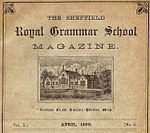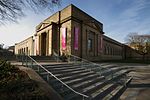Wesley College, Sheffield

Wesley College, a school to educate the sons of the laity, opened in 1838 in new buildings designed by William Flockton on Glossop Road, Sheffield, England. It was founded by Rev. Samuel Dousland Waddy (1804–1876) to "supply a generally superior and classical education, combined with religious training in the principles of Methodism" and was initially called the "Wesleyan Proprietary Grammar School". The change in name to Wesley College seems to have taken place in 1844, when a "Royal Warrant, constituting the Sheffield Wesley College a college of the University of London was forwarded to Mr Waddy (subsequently Governor, from 1844 to 1862) by Sir James Graham, which empowered the college to issue certificates to candidates for examination for the several degrees of Bachelor and Master of Arts, and Bachelor and Doctor of Laws". A year later it spurred Rev. James Gillman, William Ferguson, William Stewart and Thomas Waugh in Dublin, Ireland to consider creating a similar school in Dublin. The school accepted its first 90 boarders on 8 August 1838. By 1841 the number of pupils had increased to 172. In 1905 Wesley College was purchased by Sheffield Council and merged with Sheffield Royal Grammar School to form King Edward VII School (Upper School Site), named after the reigning monarch. The building was recently refurbished, with the addition of a sports hall and science block, as part of the BSF programme
Excerpt from the Wikipedia article Wesley College, Sheffield (License: CC BY-SA 3.0, Authors, Images).Wesley College, Sheffield
Glossop Road, Sheffield Broomhill
Geographical coordinates (GPS) Address Nearby Places Show on map
Geographical coordinates (GPS)
| Latitude | Longitude |
|---|---|
| N 53.3762 ° | E -1.4957 ° |
Address
King Edward VII Upper School
Glossop Road
S10 2PW Sheffield, Broomhill
England, United Kingdom
Open on Google Maps









